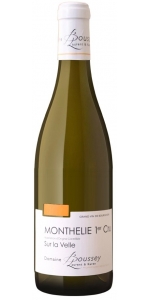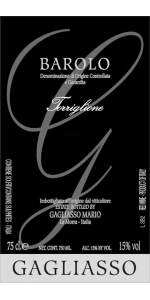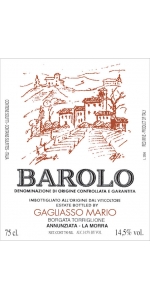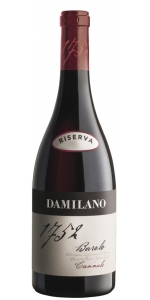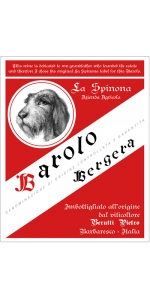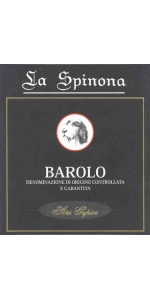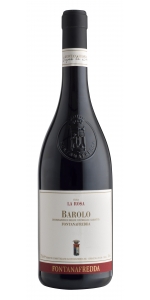Gagliasso Torriglione Barolo 2016
6 bottles with free shipping for: $330.00
12 bottles with free shipping for: $576.00
| BUY MORE! SAVE MORE! | ||||||||||||||||||||
|
Gagliasso Torriglione Barolo is 100% Nebbiolo
Aged 12 months in French Oak barrels (50% new, 50% second use), then the wine is blended in big 2500 liter foudre for 18 months. And finally, the wine is aged in the bottle for 12 months before release.
The wine offers a free range of blackberry, cassis, tar, leather and tobacco-like aromas. But, in the mouth you'll taste the jamminess and maturity of the fruit. It's a smooth, soft wine with a long strawberry fade.
Average density of vines: 5500 vines per hectare Classical Guyot method with medium-short pruning; vineyard with south exposure with medium slope. Green harvest in two different times with reduction of grapes with a production per hectare around 5500 kg . Torriglione grape are harvested very ripe with a meticulous selection; the fermentation took place in stainless steel vats with temperature controlled. The fermentation is around 33-34°C with 15-17 days of maceration ; malolactic fermentation took place spontaneously in stainless steel vats. After malolattic fermentation the wine stay for 12 months in French barrels, 50% new oak and 50% 2 years; after this period the barrels are blended in big barrels of 2500 liters for 18 months. The wine is bottled and refined for 10-12 months.
The Gagliasso Estate
The Azienda Agricola Mario Gagliasso is located in the town of La Morra, south of Piedmont, in the province of Cuneo, in the Langhe area.
The winery offers one of the most beautiful views over the Langhe area.
La Morra is located at 513 meters above sea-level, 13 km from Alba, on the top of an imposing hill with the Alps and the Monviso as a background. The hill is planted with vines, for ming huge waves and creating an amphitheatre of rare beauty.
Luca Gagliasso’s family has a long history of winemaking. Luca's grandfather began 50 years ago, at which time he bottled the first Barolo from their historic vineyard, Rocche dell'Annunziata. Around 1987, Lucas's father took over the family tradition of producing wine and brought forth a few changes: he started by using barriques from France, together with large barrels and temperature controlled steel vats. He also purchased a new vineyard. Luca began working with his father during the 2000 vintage, only part time for the first 3 years. He also worked for 3 years with their wine consultant in an analysis laboratory, and worked as a consultant for other wineries.
Luca now works alongside his father, mother, and sister on their 12 hectares of vineyards. On the weekends, Luca's sister and mother work in their restaurant as cooks – only the Gagliasso wines are served. They are currently extending their facility and in the future they plan to incorporate some guest rooms to the restaurant.
The Gagliasso family produces around 60,000 bottles: 40% Barolo, 30% Barbera, 20% Dolcetto and 10% Chardonnay. They have around 250 barriques and 6 large barrels.
Dolcetto is very fruity, aged for a small period in big cask. They produce 3 Barolos and 2 Barberas, one aged 18 months in new oak and the other one only in steel vats. They age the Barolo for 18 months in new barriques, then 12 months in a large cask. Chardonnay is cold macerated, then fermented and aged in French oak for 9 months.
Boussey Monthelie Blanc Premier Cru Sur La Velle is made from 100 percent Chardonnay.
The name Monthelie comes from Mont Lyoei, mountain of Bacchus. The "Sur la Velle" plot is located on the eastern edge of Monthélie. It borders the Volnay Clos des Chênes Premier Cru to the east. The vineyards here lie on broadly southeast facing slopes with just enough gradient to achieve good drainage.
The Monthelie Blanc Premier Cru Sur La Velle has a beautiful pale yellow color with green reflections.
It is complex and rich with delicious aromas of white flowers, fresh almonds, lemon and minerality.
The finish is long with a very good balance between the excellent ripeness and the perfect amount of acidity.
We recommend this wine with white meat, fish and seafood.
Gagliasso Torriglione Barolo is 100% Nebbiolo
Aged 12 months in French Oak barrels (50% new, 50% second use), then the wine is blended in big 2500 liter foudre for 18 months. And finally, the wine is aged in the bottle for 12 months before release.
The wine offers a free range of blackberry, cassis, tar, leather and tobacco-like aromas. But, in the mouth you'll taste the jamminess and maturity of the fruit. It's a smooth, soft wine with a long strawberry fade.
Average density of vines: 5500 vines per hectare Classical Guyot method with medium-short pruning; vineyard with south exposure with medium slope. Green harvest in two different times with reduction of grapes with a production per hectare around 5500 kg . Torriglione grape are harvested very ripe with a meticulous selection; the fermentation took place in stainless steel vats with temperature controlled. The fermentation is around 33-34°C with 15-17 days of maceration ; malolactic fermentation took place spontaneously in stainless steel vats. After malolattic fermentation the wine stay for 12 months in French barrels, 50% new oak and 50% 2 years; after this period the barrels are blended in big barrels of 2500 liters for 18 months. The wine is bottled and refined for 10-12 months.
Gagliasso Torriglione Barolo is 100% Nebbiolo
Aged 12 months in French Oak barrels (50% new, 50% second use), then the wine is blended in big 2500 liter foudre for 18 months. And finally, the wine is aged in the bottle for 12 months before release.
The wine offers a free range of blackberry, cassis, tar, leather and tobacco-like aromas. But, in the mouth you'll taste the jamminess and maturity of the fruit. It's a smooth, soft wine with a long strawberry fade.
Average density of vines: 5500 vines per hectare Classical Guyot method with medium-short pruning; vineyard with south exposure with medium slope. Green harvest in two different times with reduction of grapes with a production per hectare around 5500 kg . Torriglione grape are harvested very ripe with a meticulous selection; the fermentation took place in stainless steel vats with temperature controlled. The fermentation is around 33-34°C with 15-17 days of maceration ; malolactic fermentation took place spontaneously in stainless steel vats. After malolattic fermentation the wine stay for 12 months in French barrels, 50% new oak and 50% 2 years; after this period the barrels are blended in big barrels of 2500 liters for 18 months. The wine is bottled and refined for 10-12 months.
Gagliasso Barolo Riserva Oak Box is made from 100% Nebbiolo
Complex and intense aromas of red fruits intermixed with licorice, prune, leather, smoke and notes of toasty oak and vanilla. Full-bodied on the palate with loads of ripe dried and candied fruits, pepper and mocha.
After malolattic fermentation the wine stays for 10 months in French barrels, 10% new oak and 90% different years; after this period all barrels are blended ( 50% Torriglione and 50% Rocche dell’Annunziata) in old barrels for 48 months again. The wine is bottled and refined for 24 months.
There's a gritty, sandy quality to the tannins that would cut through roast pork stuffed with prunes.
“1752” is the name of the Damilano Barolo Cannubi Riserva, in honor of the year in which the historic bottle was first marked “Cannubi”. It still exists today perfectly conserved by the Manzone family in Bra, close to Barolo. The bottle is clearly marked as being of “1752” vintage, indicating that Cannubi historically precedes Barolo.
About the Vineyard:
The Cannubi Cru is in found within one of the 6 core zones which comprise a UNESCO heritage site in Italy. A mixture of Tortonian and Helvetian calcareous marl gives the grapes intense aromas of cherry, plum and tobacco, rose and violet in sequence. Its low potassium and high calcium/magnesium content offer the wine a fine and polished touch. The vineyard is located at about 270 m. a.s.l. and has a south-east sun exposure. Barolo Riserva Cannubi 1752 It is a small plot of about 2 hectares of Nebbiolo vines, currently between 30 and 50 years of age.
Tasting Notes:
Garnet ruby red in color, the bouquet is intense and balanced, with notes of violet, red fruit, cherry and plum, spices, liquorice, cocoa, leather and tobacco. Dry, robust, full-bodied, very persistent, rich and velvety
Food Pairing:
This wine is excellent with typical piedmontes pasta (tajarin, ravioli); perfect with red meat, braised and roast meat, game and absolutely ideal with all types of cheeses.
Review:
La Spinona Cru Bergera Barolo is made from 100 percent 100% Nebbiolo Lampia
The Beruttis bought 4 hectares in 1994 in the then relatively unknown zone of Novello which lies on the confines of Monforte and Barolo. A Sorì is an entirely south-facing vineyard. This Sori lies at 230 meters. It is named for the great grandfather that started the Barbaresco vineyards. The vines are an average of 40 years old. Bergera comes from the mid part of the vineyard and is dedicated to Pietro's grandfather who started the estate.
Brilliant deep ruby red with garnet reflections. Rich fruity bouquet with hints of cherries, violets liquorice and mint. Good structure with full, cherry-ripe flavors. The tannins are gentle and the spice subtle. It is an elegant wine of great finesse and drinkability. Excellent with wild game, roast, braised or stewed red meats, truffle dishes and aged cheeses.
Review:
"Underbrush, violet and new leather aromas come to the forefront on this fragrant red. The bright, linear, elegantly structured palate offers pomegranate, cranberry and star anise framed in taut, fine-grained tannins. It has an almost salty finish. Drink 2026–2036. - KERIN O’KEEFE"
- Wine Enthusiast (November 2021), 94 pts
La Spinona Sori Gepin Barolo is made from 100 percent Nebbiolo.
Color: Brilliant deep ruby red with garnet reflections.
Bouquet: Rich fruity bouquet with hints of violets , spice and mature berries.
Taste: Densely structured with full, complex flavors of ripened red fruits, wood and earth tones. A Huge wine of elegant proportions that become velvety and graceful with aging.
The Beruttis bought 4 hectares in 1994 in the then relatively unknown zone of Novello which lies on the confines of Monforte and Barolo. A Sorì is an entirely south-facing vineyard. This Sori lies at 230 meters. It is named for the great grandfather that started the Barbaresco vineyards. The vines are an average of 40 years old. The first vintage was the 1996.
The Spinona is a special breed of Piedmontese hunting Dog, which the Berutti’s raise. As the legend goes, this particular dog, Baica, received her place of honor on the label for an act of great heroism. She saved the Berutti’s only son from drowning in the irrigation lake when he was a baby. The son then became a veterinarian to save the dogs and later obtained a degree in agronomy to take care of the vineyards.
Brilliant deep ruby red with garnet reflections. Rich fruity bouquet with hints of violets, spice and mature berries. Densely structured with full, complex flavors of ripened red fruits, wood and earth tones. A huge wine of elegant proportions that becomes velvety and graceful with aging.
Reviews:
On the savory side, this red opens with freshly mowed grass, hay and eucalyptus aromas before revealing cherry, strawberry, rose and mineral flavors. Fleshy, with a matrix of dense tannins flexing their muscles on the finish. Shows excellent potential. Best from 2023 through 2042.
-Wine Spectator 96 Points
Floral and red fruit nose. Supple attack, very polished and concentrated, with fine-grained tannins and ample acidity. This has a linear drive, precision. and a very long finish. The rewards will be substantial for the patient consumer.
-Decanter 97 Points
- back
Domaine du Colombier Hermitage Rouge is made from 100 percent Syrah.
Perfect with beef ribs, grilled meats and cheese.
Manually harvested with destemmed grapes and fermented for about 2 to 3 weeks in temperature controlled vats, with an ageing period of 12 months, 65% in oak barrels and 35% in concrete tanks.
Review:
Brought up in 30% new demi-muids, with the balance in used barrels, the 2017 Hermitage is beautifully pure and layered, with smoking good notes of crème de cassis, white flowers, crushed rocks, and violets. Deep, full-bodied, and concentrated on the palate, it has plenty of tannins and is going to need 5-7 years of bottle age. This is a sensational Hermitage from Colombier that will drink well for 25+ years.
These wines are made by the talented Florent Viale and shine for their purity as well as character. While the winemaking here is traditional, with the wines destemmed and brought up mostly in used demi-muids, the purity of fruit can give the impression that wines are more modern styled than they are. They will all benefit from short-term cellaring.
-Jeb Dunnuck 96+ Points
Ghost Hull Cabernet Sauvignon is made of 100 percent Cabernet Sauvignon.
Aromas of blackberry, elderberry and ripe plum are accentuated by notes of mocha, fresh tarragon, vanilla and oak. The palate is full-bodied and offers a lovely balance of acidity and tannins accompanied by rich flavors of dark fruit and black currant, ending with a juicy and lingering finish



